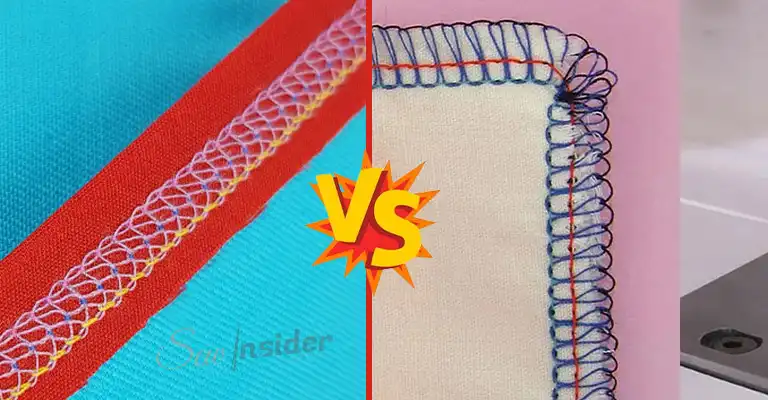The base difference between a serger and a cover stitch is a serger will assist you with an even workplace. That would have you to cut knives which, on the contrary, a cover-stitch doesn’t possess. Again, a cover stitch is a single looper while a serger can have two.

Differences Before a knit: Coverstitch vs Serger
Technically the functionalities of a cover stitch and a serger would be similar. The base visualized difference you’ll see is after the knit-work. A serger overlocks the edge portion and also cuts off the uneven ones.
Number of Needles
Sergers usually have two needles and they can handle up to 8 spools of threads at once. The old modeled sergers have three to four needles, and a cover stitch got three needles.
Lines and Layers
In usual cases, a serger creates an even line of two rows and makes a stretchable panel for either chain stitches or stitches that make it flexible to have a stretchy effect. While a cover-stitch focuses on a single-layer-fine-lines.
Stitching Speed
There is an often-made query that a serger has a less wide area for work, whereas the cover-stitch is fair. But the cover-stitch has a speed of 1100 stitches/ minute, and a serger delivers 1700 stitches/ minute.
Any Cutting Edge Upperhand?
Even though the dissimilarities aren’t that highly noticeable yet it is the choice of most users that they give a serger more scores. The reason is that most of the sergers are combined with the facilities of a cover-stitch. You might give a view to this page for better visualization
Bernina Cover-Stitch Machine vs Juki Cover-Stitch Machine
It’s often said that Bernina is not manufactured lately and the Juki is making the “Bernina” now. This means that they have an unnoticeable dissimilarity.
Bernina has an MTC system that controls the optimal threads and enabled a swing-out upper-knife arm for a wide workspace. There is an automatic safety switch installed with an LCD screen display. A smooth functioning machine for better serge and seam.
The Juki is in no way dissimilar. This can work on any fabric from georgette to heavy ones. Stretchable stitch width is 2.5-5mm and the finishing one satisfying job. So, if you’re confused if they have a considerable difference then it’s not. But both are running in the market but mostly Juki Mcs-1500.
What Is an Overlock Machine?
Overlocks are the criterion for a perfect preview cloth-wears with zero possibilities of open edges. Even a few years back we didn’t focus on the overlocks as we were okay with the general stitches to wrap up the edges.
Overlocks are done for a stretchy effect on the end-line of your tees and many more closet items, and certainly, the even edges give a professional vibe always. The serger has often been named an overlocker and vice versa.
Coverstitch Machine UK vs Janome Overlocker/Serger
The UK cover stitches function as any other available in the stocks. In most cases, the thread limitation is up to 5 spools, and then in some cases, it can be extended up to 8 spools.
The Janome overlocker has an installed overlocker system that prevents the cloth edges from raveling. To be precise the Janome uses seamstresses with overcast stitches which is technically similar to overlock. So, this overlocker is similar to a serger and vice versa.
Ultimately a serger is a better option always if you like it professionally. So, Janome is preferable. Learn to use a cover stitch machine.
Overlocker With Cover-Stitch Combined
Technically sergers come with cover-stitch and or without cover-stitch and if you want easy work done it is highly recommended to take a serger combined with cover stitch. The best ones available in the market are Juki MO-735, Singer professional 5 14T968DC, Bernetter B48, and many more.
FAQ
Q. Can’t the cover-stitch do two-row finishes like sergers?
Ans: Yes, they do. When you are using a single needled cover stitch, the backside will be a single-layered chain stitch. Else if you’re using two or three needles then they finish in two-row work. Still, cover stitches don’t go with helping the edges, so sergers are the rescuer.
Conclusion
Both cover-stitch and serger are important and the advanced models of sergers allow you to have a cover-stitch along. Consequently, you lock the edges with smooth professional overlocks with fitted seams. Also having the strength and stretch flexibility is something on-trend. So overlocking is a ruling criterion in styling articles of clothing.
Leave a Reply